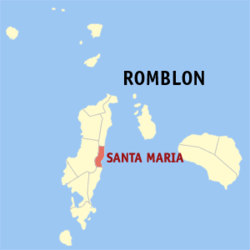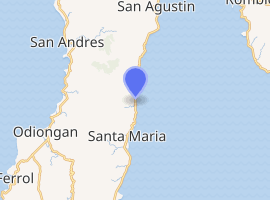Santa Maria, Romblon
Santa Maria, officially the Municipality of Santa Maria, (formerly Imelda), is a 5th class municipality in the province of Romblon, Philippines. According to the 2015 census, it has a population of 8,508 people.[4]
Santa Maria | |
|---|---|
| Municipality of Santa Maria | |
 Map of Romblon with Santa Maria highlighted | |

| |
.svg.png) Santa Maria Location within the Philippines | |
| Coordinates: 12°26′30″N 122°06′15″E | |
| Country | |
| Region | Mimaropa (Region IV-B) |
| Province | Romblon |
| District | Lone district |
| Founded | 1982 |
| Barangays | 6 (see Barangays) |
| Government | |
| • Type | Sangguniang Bayan |
| • Mayor | Lorilie "Bic-Bic" M. Fabon [2] |
| • Vice Mayor | Dennis F. Corpin [2] |
| • Congressman | Eleandro Jesus Madrona |
| • Councilors | Nonoy Madrid (NP) May Manoy (NPC) Tess Mangaya (NP) Roland largueza (NPC) Joy Astillo (NP) Limuel Manago (NP) Vivian Mendezabal (NPC) Limuel Mijares (NPC) |
| • Electorate | 6,397 voters (2019) |
| Area | |
| • Total | 36.20 km2 (13.98 sq mi) |
| Elevation | 11.8 m (38.7 ft) |
| Population (2015 census)[4] | |
| • Total | 8,508 |
| • Density | 240/km2 (610/sq mi) |
| • Households | 1,880 |
| Economy | |
| • Income class | 5th municipal income class |
| • Poverty incidence | 29.81% (2015)[5] |
| • Revenue (₱) | 40,492,925.42 (2016) |
| Time zone | UTC+8 (PST) |
| ZIP code | 5508 |
| PSGC | |
| IDD : area code | +63 (0)42 |
| Climate type | tropical climate |
| Native languages | Onhan language Tagalog |
History
Santa Maria was known in Spanish times as Cagbagacay, after a bamboo plant called "bagacay" in the local dialect, which was in abundance in the area. Back then it was still a barrio of Guintigui-an town. In 1910, barrio Cagbagacay was renamed Concepcion after its patron the Immaculada Concepcion.[6]
On 12 September 1982, barrio Concepcion (Norte) together with barrios Bonga and Concepcion Sur were organized and created into a new municipality by virtue of Batas Pambansa Blg. 234, authored by Assemblyman Nemesio Ganan Jr. The new municipality was named "Imelda", in honor of then First Lady Imelda Marcos, as well as to distinguish the town from Concepcion municipality on Maestro de Campo Island, also in Romblon.[6][7]
After the People Power Revolution in 1986 which toppled the regime of dictator Ferdinand Marcos, the town was renamed Santa Maria on 17 April 1988 by virtue of Republic Act No. 6651, again in honor of its patron the Immaculate Conception of the Blessed Virgin Mary. Three new barangays were added to the municipality: San Isidro, Paroyhog, and Santo Nino.[8]
Geography
Situated on the eastern side of Tablas Island, Santa Maria faces the Sibuyan Sea. It is bounded in the north by the municipality of San Agustin, in the south by the municipality of Alcantara, in the west by the municipality of Odiongan and in the east by Romblon Pass. Santa Maria has a total land area of 3,620 hectares (8,900 acres). It is generally mountainous with a limited portion of the plain area along the coast. The town is considered one of the most peaceful areas in the province.[9]
Climate
| Climate data for Santa Maria, Romblon | |||||||||||||
|---|---|---|---|---|---|---|---|---|---|---|---|---|---|
| Month | Jan | Feb | Mar | Apr | May | Jun | Jul | Aug | Sep | Oct | Nov | Dec | Year |
| Average high °C (°F) | 28 (82) |
29 (84) |
30 (86) |
31 (88) |
31 (88) |
30 (86) |
29 (84) |
29 (84) |
29 (84) |
29 (84) |
29 (84) |
28 (82) |
29 (85) |
| Average low °C (°F) | 21 (70) |
21 (70) |
22 (72) |
23 (73) |
25 (77) |
25 (77) |
25 (77) |
25 (77) |
25 (77) |
24 (75) |
23 (73) |
22 (72) |
23 (74) |
| Average precipitation mm (inches) | 31 (1.2) |
20 (0.8) |
25 (1.0) |
39 (1.5) |
152 (6.0) |
269 (10.6) |
314 (12.4) |
285 (11.2) |
303 (11.9) |
208 (8.2) |
95 (3.7) |
70 (2.8) |
1,811 (71.3) |
| Average rainy days | 9.5 | 7.1 | 9.0 | 11.3 | 21.0 | 25.7 | 28.1 | 26.5 | 27.3 | 24.6 | 16.5 | 12.1 | 218.7 |
| Source: Meteoblue [10] | |||||||||||||
Barangays
Santa Maria is politically subdivided into 6 barangays.
- Bonga
- Concepcion Norte (Poblacion)
- Concepcion Sur
- Paroyhog
- Santo Niño
- San Isidro
Demographics
| Population census of Santa Maria | ||
|---|---|---|
| Year | Pop. | ±% p.a. |
| 1990 | 6,459 | — |
| 1995 | 7,785 | +3.56% |
| 2000 | 7,324 | −1.30% |
| 2007 | 7,520 | +0.36% |
| 2010 | 7,683 | +0.78% |
| 2015 | 8,508 | +1.96% |
| Source: Philippine Statistics Authority[4][11][12][13] | ||
According to the 2015 census, it has a population of 8,508 people. Onhan, also known as Taga-onhan or Inunhan (Alcantaranhon style), is the native language of majority of its inhabitants, while Romblomanon or Ini is the native tongue in the two northern barangays of Bonga and Santo Niño (Bitaugan).
Local government
Pursuant to Chapter II, Title II, Book III of Republic Act 7160 or the Local Government Code of 1991,[14] the municipal government is composed of a mayor (alkalde), a vice mayor (bise alkalde) and members (kagawad) of the legislative branch Sangguniang Bayan alongside a secretary to the said legislature, all of which are elected to a three-year term and are eligible to run for three consecutive terms.
The incumbent mayor is Lorilie "Bic-Bic" Fabon y Manito y Fetalino while the incumbent vice mayor is Dennis Corpin y Fortu, nephew of the late Calatrava mayor Prudencio Fortu.[15]
Sister city
![]()
See also
- List of renamed cities and municipalities in the Philippines
References
- "Municipality". Quezon City, Philippines: Department of the Interior and Local Government. Retrieved 31 May 2013.
- "Halalan 2019 Philippine Election Results". ABS-CBN News.
- "Province: Romblon". PSGC Interactive. Quezon City, Philippines: Philippine Statistics Authority. Retrieved 12 November 2016.
- Census of Population (2015). "Region IV-B (Mimaropa)". Total Population by Province, City, Municipality and Barangay. PSA. Retrieved 20 June 2016.
- "PSA releases the 2015 Municipal and City Level Poverty Estimates". Quezon City, Philippines. Retrieved 12 October 2019.
- About Santa Maria Wikimapia. Retrieved on 2012-04-16.
- "An Act Creating the Municipality of Imelda in the Province Of Romblon" Archived 2014-10-26 at the Wayback Machine PhilippineLaw.info Retrieved on 2012-04-16.
- "An Act Changing the name of the Municipality of Imelda in the Province Of Romblon to Municipality of Santa Maria" Chan Robles. Retrieved on 2012-04-16
- Profile: Santa Maria Romblon Travel Guide. Retrieved on 2012-04-16.
- "Santa Maria: Average Temperatures and Rainfall". Meteoblue. Retrieved 28 April 2020.
- Census of Population and Housing (2010). "Region IV-B (Mimaropa)". Total Population by Province, City, Municipality and Barangay. NSO. Retrieved 29 June 2016.
- Censuses of Population (1903–2007). "Region IV-B (Mimaropa)". Table 1. Population Enumerated in Various Censuses by Province/Highly Urbanized City: 1903 to 2007. NSO.
- "Province of Romblon". Municipality Population Data. Local Water Utilities Administration Research Division. Retrieved 17 December 2016.
- "An Act Providing for a Local Government Code of 1991". 8th Congress of the Republic of the Philippines. Retrieved April 21, 2014.
- "santa maria (imelda) - romblon - City/Municipality Results - Eleksyon2016 - Results -". GMA News Online.
- Press Release. Archived 2012-08-04 at Archive.today Makati City Portal. Retrieved on 2012-04-16.